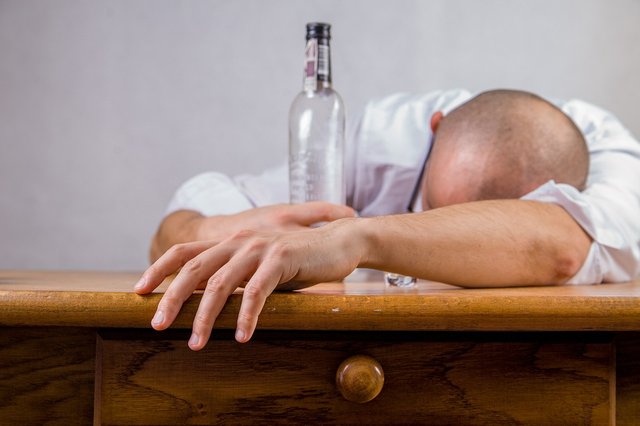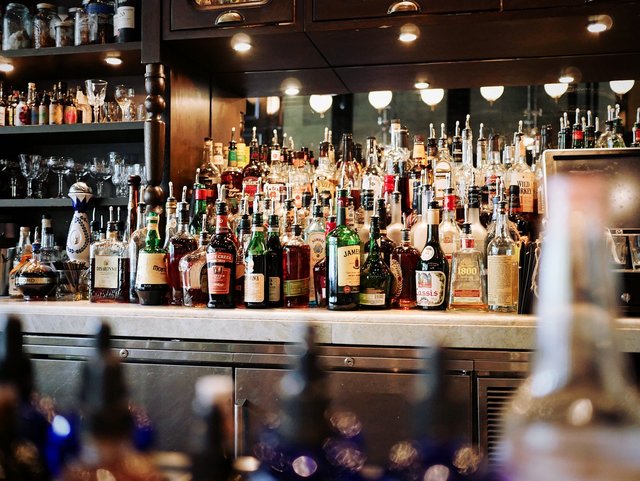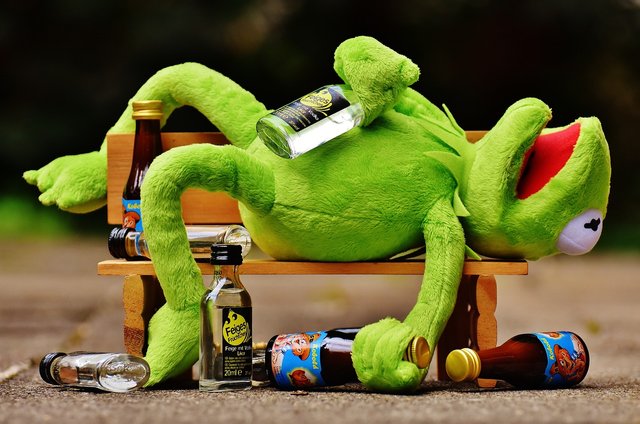
Picture source: Pixabay,(License : CCO)
Some years back when i was in school, i was invited by my course mates to celebrate the conclusion of our final year examination. I can't forget that faithful day of which for the first time in my life I was completely intoxicated and hangoverish. We drank a lot of alcohol for hours celebrating our success thinking we were enjoying, not knowing we were killing ourselves. The effect of the alcohol made me sleep outside my home that very day. Non of us could help each other because we were all drunk. Not until midnight when i realized where I was, by then the community security operatives had carried us to their office where we rested till dawn. How terrible!
I went home in the morning looking odd and dirty, few days later I started experiencing some health challenges as a result of the excessive intake of alcohol (spirit to be precised). I had to go for medication until I became better. So I vowed never to abuse alcohol the way I did as it almost took my life.
Alcohols are one of the most dangerous and poisonous drugs ever. They are volatile, colorless, pungent liquids, and composed of three chemical elements which are carbon, hydrogen, and oxygen. Ethyl alcohol (ethanol) is the type we take in alcoholic drinks. It may also be prescribed medically, to stimulate the appetite, or form a medicinal base in which other ingredients are dissolved.
Methyl alcohol (methanol, or "wood alcohol") as it is called is used commercially as a fuel and solvent. It is very poisonous, and drinking it causes blindness and even death.
Alcoholic Drinks and Strength

Picture source: Pixabay (CCO licensed)
If we look at the domestic and industrial production of alcoholic drinks, we will find out that ethyl alcohol is produced by fermentation; that is, the degeneration of a starch (such as maize, barley, rice, potatoes, grapes) by bacterial action. The drink that results depends on the starch used; for example malt and barley give beer, grapes give wine, beers and wines are produced by fermentation alone. Only about a 15% level of alcohol is possible by this method.
Spirits, with their higher alcoholic level (whiskey, gin, vodka, liqueurs, etc) also require distillation. That is, the alcohol is evaporated off, leaving water behind, and resulting in a higher alcoholic concentration in the eventual liquid. Distilled alcohol may also be added to wines (sherry, port, etc) and beers, to strengthen them.
Commercially, the strength of an alcoholic beverages is expressed as so many degrees proof. This refers to the liquid's specific gravity not to the percentage of alcohol it contains. Proof measurement regulations vary between countries. For example, a spirit that is 100 proof (written 100° ) contains 50% alcohol.
Alcohol in the Body
Have you ever imagined the amount of alcohol in the body that could result to hangover? Do you know that about 20% of any alcohol drunk is absorbed in the stomach, and 80% in the intestines?
When alcohol is taken and absorbed, it is then carried around the body by the bloodstream and the liver breaks down or oxidizes the alcohol at an almost constant rate: usually about 2 1/2 bottles (1 pint) of beer or 1 oz of whiskey per hour. During this process, about 90% of the alcohol is eventually disposed off , forming both carbon dioxide and water as end products. While the remaining 10% is eliminated through the lungs and in the sweat.
Alcohol in the body has four main effects which are the provision of energy (alcohol has high calorific value, but contains no nutrients), acts as an anesthetic on the central nervous system, slowing it down and impairing its efficiency, stimulates urine production (with heavy intake of alcohol, the body loses more water than is taken in, and the body cells become dehydrated), that's why we always urinate after taking excessive alcohol. Alcohol also puts part of the liver temporarily out of action. After heavy drinking, as much as two third of the liver can be nonfunctioning but it is usually fully recovered within a few days .
Blood Alcohol Level and Behavioral Effect

picture source : Pixabay (CCO)
The effect of alcohol on behavior depends on the amount reaching the brain via the bloodstream. This blood alcohol level is determined by several factors, apart from the quantity of alcohol drunk.
The size of the liver decides the rate of oxidation and elimination, the size of the person decides the amount of blood in the system, because blood volume is proportionate to size. The larger the person, the greater the diluting effect of the blood on the alcohol consumed, and the more it takes to produce the same effect. The speed and manner in which the alcohol is consumed is important. The longer one takes to drink a given quantity, the less effect it has. Alcohol consumed on an empty stomach will have a greater and more immediate effect than that consumed during or after eating. Food acts as a buffer to absorption.
As the level of alcohol in the blood rises, the drinker's brain and nervous system are increasingly affected and changes occur in his behavior.
The effect of alcohol in our behaviors can be determined by the percentage intake. In a sequential manner, when a person takes about 0.02% the person still have sense of warmth, and friendliness. Though the person's visual reaction time slows. When it gets to 0.04%, the driving ability at speed is impaired. When it gets to 0.06%, there is always feelings of mental relaxation and general well-being. When it gets to 0.09%, there will be exaggerated emotions and behavior, then the person might start talking too much with a loud voice. When it gets to 0.12%, the person's speech becomes staggering, and fumbling. When it reaches 0.15%, the person will be Intoxicated. When it gets to 0.20%, the person will be completely Incapacitated, depressed and loss of sphincter control. When it gets to 0.30%, the person would be drunk to stupor. When it gets to 0.40%, the person would be in coma. When it gets to 0.060% + lethal dose, then the person will die through heart and respiratory failure. Fortunately, lethal doses seldom occur as unconsciousness and vomiting force the drinker to stop.
The behavioral effects of alcohol make drinking and driving very dangerous, both to the drinker and to others. Tests have shown that errors of judgement and control increase as soon as there is any alcohol in the blood stream. Therefore many countries prescribe a legal limit to the blood alcohol level of anyone in charge of a vehicle.
How we get Drunk
.jpeg)
Oktoberfest 2011 drunk male sleep, (License : Public Domain, Author: Usien) Source:wikimedia commons
Alcohol is a physiological depressant, as consumption occurs, the transmission of impulses in the nervous system becomes slowed. First to be affected are the higher levels of the brain : inhibitions, worry, and anxiety are dissolved, resulting in a sense of well-being and euphoria.
As the lower levels of the brain become affected, co-ordination, vision, and speech are impaired. The small blood vessels of the the skin become dilated (widen). Heat is radiated and the drinker feels warm. This means that blood has been diverted from the internal body organs, where the blood vessels are already constricted by the effect of alcohol on the nervous system. So, at the same time, the temperature of internal body organs falls. Any increase in sexual desire is due to the depression of the usual inhibitions.
Alcohol is not an aphrodisiac physical sexuality is more and more impaired as blood alcohol level rises. Eventually, the poisoning effect of excess alcohol causes nausea and possible vomiting, and may leave the drinker with usual symptoms of hangover (hangover is the physical discomfort that follows the consumption of too much alcohol. Like headache, upset stomach, thirst, dizziness, and irritability).
Alcohol and the Law
.jpeg)
picture source : Pxhere(CCO Public Domain)
What does the law say about alcohol??Chemically, alcohol is one of the most dangerous drugs known to man. But, over years of experience, society has managed to develop cultural attitudes which allow alcohol to be available without it causing great disruption or harm. However, legal restrictions are needed to reinforce these attitudes.
Most countries have a minimum age for its purchase, restrict the number of hours of the day during which it can be sold, control the number, ownership, and location of bars and liquor stores, and keep up strict observation of their orderliness.
In my country Nigeria, the legal age of buying and drinking alcohol is 18 and the people are advised to "drink responsibly ". The reason is to curb the excessive abuse of alcoholic drinks.
Conclusion
Like I said earlier, "alcohol is one of the most dangerous drugs or should I say chemical ever" . It can lead to many health problems and even give one a bad name. We must have heard or seen cases of sexual abuses (rape), accidents, fights, and so on as a result of alcoholic influence.
A lot of people abuse alcohol and that is why they found themselves in ugly situations. If we must drink alcohol then we must "drink responsibly" and at the right time within the confines of the law as to live healthy and stay out of embarrassment.
References
[1] Alcohol -Wikipedia
[2] Alcohol and Sugar
[3] Effects Of Alcohol On The Brain: How Booze Works On Your Brain
[4] Alcohol Law
[5] The Effects of Alcohol on Your Body
[6] Alcohol - ADF - Alcohol $ Drug Foundation

.png)
Congratulations! This post has been upvoted from the communal account, @minnowsupport, by masterwriter from the Minnow Support Project. It's a witness project run by aggroed, ausbitbank, teamsteem, someguy123, neoxian, followbtcnews, and netuoso. The goal is to help Steemit grow by supporting Minnows. Please find us at the Peace, Abundance, and Liberty Network (PALnet) Discord Channel. It's a completely public and open space to all members of the Steemit community who voluntarily choose to be there.
If you would like to delegate to the Minnow Support Project you can do so by clicking on the following links: 50SP, 100SP, 250SP, 500SP, 1000SP, 5000SP.
Be sure to leave at least 50SP undelegated on your account.
Downvoting a post can decrease pending rewards and make it less visible. Common reasons:
Submit
On the topic of usefulness of alcohol, having concentrated, alcohol affects the brain in the most remarkable way: it lowers the excitability of nerve cells, a person calms down; and also creates a good mood. But I'm here not just to tell and show that alcohol is not so simple, but to give you the opportunity to purchase licenses https://liquorlicenseauctioneers.com/florida/counties/manatee and give you the opportunity to create your own business in the future, so take licenses and change your life
Downvoting a post can decrease pending rewards and make it less visible. Common reasons:
Submit
This post has been voted on by the steemstem curation team and voting trail.
There is more to SteemSTEM than just writing posts, check here for some more tips on being a community member. You can also join our discord here to get to know the rest of the community!
Downvoting a post can decrease pending rewards and make it less visible. Common reasons:
Submit